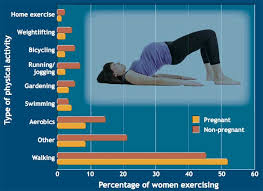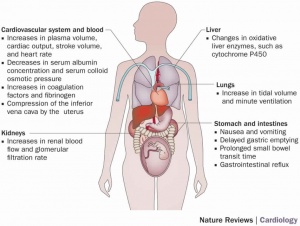Physical Activity and Pregnancy
- Please do not edit unless you are involved in this project, but please come back in the near future to check out new information!!
- If you would like to get involved in this project and earn accreditation for your contributions, please get in touch!
Tips for writing this page:
Please consider including the following topics in this page plus other subjects that you think are appropriate:
- x
- x
A quick word on content:
When you write this page please include:
- Evidence (where appropriate and available
- References
- Images and videos
- A list of open online resources that we can link to
- Links to other pages in this project
Example content:
Original Editor - Mariam Mohana
Top Contributors - Nicole Hills, Mariam Hashem, Wendy Walker, Kim Jackson, Lucinda hampton, Admin, Tarina van der Stockt, Simisola Ajeyalemi, Candace Goh, Rishika Babburu, 127.0.0.1, Tony Lowe, Michelle Lee, Vidya Acharya and Rucha Gadgil
Introduction[edit | edit source]
Physical activity is defined as any bodily movement produced by skeletal muscles that result in energy expenditure. Exercise is a subset of physical activity that is planned,structured, repeated and has a final or an intermediate objective to the improvement or maintenance of physical fitness[1]
-Pregnancy could be a great time for life style modifications. Moderate intensity exercises are proven to be beneficial for both mother and fetus in low risk pregnancy with the necessary modifications[2].
Prevalence:[edit | edit source]
-In the United states, one study reported that only 15.8 % of women are engaged in exercises during pregnancy at the recommended level[3].
Benefits of physical activities for the mother:[edit | edit source]
* Exercise and weight management:[edit | edit source]
-Weight gain during pregnancy , known as Gestational weight gain (GWG). The Institute of Medicine recommends GWG for underweight, normal weight, overweight, and obese women of 12.5-18, 11.5-16, 7-11.5 and 5-9 kg respectively[4]. A high percentage of women exceed the recommended weight.[5]
-Excessive GWG is associated with high risk of gestational diabetes mellitus (GDM), hypertension[6], cesarean delivery and postpartum weight retention[7].
-Regular physical activity during pregnancy can reduce GWG by an average of 6.8 pounds compared to women who do not exercise regularly[8].
* Exercise and Cardiac and respiratory fitness:[edit | edit source]
-Pregnancy is accompanied by many cardiac and respiratory changes that begin during the fifth week of gestation and last until about a year after delivery[9], Cardiac output and blood volume increase up to 40%[10] [11]. Tidal volume and oxygen consumption (VO2) also increase to supply the oxygen requirements of the fetus.
-Aerobic exercise such as swimming, static cycling and general floor exercise programs, at least two to three times per week is recommended to maintain cardiovascular fitness[12], reduces ventilatory demands, enhances the breathing pattern and eventually inhibits exertional breathing problems occur in pregnancy.
*Exercise and Psychological well-being:[edit | edit source]
-pregnancy can also be a time of major emotional changes. M any women suffer alterations in mood and even prenatal depression. Recent studies have estimated the prevalence of depression during pregnancy to be between 10% and 30%[13].
-The women who keep fit during pregnancy are more relaxed and cope better with the emotional and physiological strains of pregnancy, this is attributed to a number of positive effects from exercise such as weight management, better body image and self-esteem, improved sleep, and increased energy level[14]
-Exercises may also be effective in treating antenatal depression[15].
*Back pain: [edit | edit source]
-Pregnant women typically develop lumbar lordosis, which contribute to the very high prevalence (50%) of low back pain in pregnant women[16].
-Exercises in general in addition to Lumbar stabilization exercises are helpful to reduce the intensity of back pain[17][18].
*Labor outcomes:[edit | edit source]
-Pregnant women who maintain a regular exercise routine, experience less painful , and short duration delivery[19]. This is attributed to the exercise effect on inducing metabolic and hormonal changes that may impact uterine contractility and endurance[20].
-Exercises during pregnancy are also associated with reduced need for Cesarean section[21].
*Urinary Incontinence: [edit | edit source]
-Pelvic floor strengthening exercises during pregnancy are helpful in prevention and reducing the symptoms of urinary incontinence[22].
*Physical activities and high risk pregnancy:[edit | edit source]
-Pre-eclampsia:[edit | edit source]
Pre-eclampsia is a serious complication of pregnancy occurring in about 2% to 8% of women. it is defined by increases blood pressure and protein in the urine, but women often suffer no symptoms initially. Pre-eclampsia might interfere with food and oxygen passing to the baby, by constriction of blood vessels in placenta, thus inhibiting baby's growth and causing preterm delivery. It may also affect the mother's kidneys,liver, brain and or clotting system.
-Exercises are proven to increase blood flow and reduce risk of high blood pressure. So there is the potential for exercise to help prevent pregnant women developing Pre-eclampsia.[23]
-Glucose intolerance and Gestational Diabetes Mellitus:[edit | edit source]
-Gestational Diabetes Mellitus (GDM) is one of the most common complications of pregnancy.[24] GDM is associated with a wide range of adverse outcomes for women and their babies.[25]
-A study found that women who engaged in physical activities before and during pregnancy experienced 69% reduced risk of developing GDM.[26]
*Physical activities effects on the fetus and the newborn:[edit | edit source]
-Exercises are not associated with birth weight reduction.[27] And found to reduce the risk of preterm birth.[2].
-Exercises boost the neuro-behavioral profile and orientation level of the new born; they are more alert and interested in their surroundings, and less demanding on their mothers. Also, babies of physically active pregnant women are lighter and leaner than offspring from nonphysically active pregnant women.[2]
-A study that compared placental growth and morphometric measurements found faster placental growth rate, and greater scores on the morphometric indexes of placental function with exercising pregnant women.[28]
The American College of Sport Medicine recommendations and guidelines for physical activities in pregnancy:[29][edit | edit source]
-The overall health, obstetric, and medical risks should be reviewed before a pregnant women is prescribed an exercise program.
-In the absence of contraindications a pregnant women should be encouraged to engage in regular, moderate intensity physical activity.
-Pregnant women are encouraged to spend 30 minutes or more of moderate intensity physical activity on most, and preferably all days of the week.
-Moderate intensity physical activity is defined as activity with an energy requirement of 3-5 metabolic equivalents (METS). For most healthy adults, this is equivalent to brisk walking at 3-4 mph.
-After the 13th week of pregnancy, about (300 kcal) per day are required to meet the metabolic needs of pregnancy. this energy requirement is increased further when daily energy expenditure is increased through exercise, especially with weight bearing exercises, such as walking.
-Proper hydration and subjective feelings of heat stress are very important.
-Supine position should be avoided as much as possible during rest and exercise after the first trimester, as it results in relative obstruction of venous return.
-Motionless standing also should be avoided as it is associated with a significant decrease in cardiac output.
-Exercises that use large muscle groups in a continuous rhythmic manner such as aerobic exercises, walking, hiking, jogging/running, aerobic dance, swimming, cycling, rowing, cross country skiing, skating, dancing and rope skipping are beneficial and has not been associated with adverse effects.
-Extra caution should be taken with activities that increase the risk of falls.
-Resistance Training (low weights with multiple repetitions) is safe and effective during pregnancy.
-The recommended intensity of physical activity should be 60-90% of maximal heart rate, and rating of perceived exertion should be 12-14 ( somewhat hard) on the 6-20 scale for pregnant women who did not engage in regular exercise before pregnancy.
-Women who were regular exercisers before pregnancy and who have uncomplicated, healthy pregnancies should be able to engage in high intensity exercise programs.
-Non-stress fetal heart testing and ultrasound to assess fetal growth should be considered if clinically indicated in high intensity exercisers.
| Absolute contraindications: |
|
| Relative contraindications: |
| • Severe anemia
• Unevaluated maternal cardiac arrhythmia • Chronic bronchitis • Poorly controlled type I diabetes • Extreme morbid obesity • Extreme underweight (body mass index <12) • Intrauterine growth restriction in current pregnancy • Poorly controlled hypertension/preeclampsia • Orthopedic limitations • Poorly controlled seizure disorder • Poorly controlled thyroid disease • Heavy smoker |
| Warning signs: |
|
References[edit | edit source]
References will automatically be added here, see adding references tutorial.
- ↑ Caspersen, C. J., Powell, K. E., & Christenson, G. M. (1985). Physical activity, exercise, and physical fitness: definitions and distinctions for health-related research. Public Health Reports (Washington, D.C. : 1974), 100(2), 126–31. https://doi.org/10.2307/20056429)
- ↑ 2.0 2.1 2.2 VICTOR KATCH Katch, Victor ( 2017, February, 5) Pregnancy And Physical Activity Retrieved from http://michigantoday.umich.edu/pregnancy-and-physical-activity/.
- ↑ Evenson KR, Savitz DA, Huston SL. Lesure-time physical activity among pregnant women in the US. Paediatr Perinat Epidemiol 2004; 18:400–407.
- ↑ Barakat, R., Perales, M., Garatachea, N., Ruiz, J. R., & Lucia, A. (n.d.). Exercise during pregnancy . A narrative review asking : what do we know ?, 1377–1381. https://doi.org/10.1136/bjsports-2015-094756
- ↑ Davenport MH, Steinback CD, Mottola MF. Impact of pregnancy and obesity on cardiorespiratory responses during weight-bearing exercise. Respir Physiol Neurobiol 2009;167:341–7.
- ↑ Gaillard R, Durmus B, Hofman A, et al. Risk factors and outcomes of maternal obesity and excessive weight gain during pregnancy. Obesity 2013;21:1046–55.
- ↑ Hedderson, M., EP, G., & Ferrara, A. (2011). Gestational Weight Gain and Risk of Gestational Diabetes Mellitus. Obstet Gynecol, 115(3), 597–604. https://doi.org/10.1097/AOG.0b013e3181cfce4f.Gestational)
- ↑ Evenson KR, Savitz DA, Huston SL. Lesure-time physical activity among pregnant women in the US. Paediatr Perinat Epidemiol 2004; 18:400–407.
- ↑ Clapp JF III, Capeless E. Cardiovascular function before, during, and after the first and subsequent pregnancies. Am J Cardiol 1997;80:1469–73.
- ↑ Geva T, Mauer MB, Striker L, et al. Effects of physiologic load of pregnancy on left ventricular contractility and remodeling. Am Heart J 1997;133:53–9.
- ↑ Gilson GJ, Samaan S, Crawford MH, et al. Changes in hemodynamics, ventricular remodeling, and ventricular contractility during normal pregnancy: a longitudinal study. Obstet Gynecol 1997;89:957–62.
- ↑ *Exercise and Psychological well-being: fckLR-Pregnancy can also be a time of major emotional change. Many women suffer alterations in mood and even prenatal depression. Recent studies have estimated the prevalence of depression during pregnancy to be between 10% and 30% .fckLRfckLR-The women who keep fit during pregnancy are more relaxed and cope better with the emotional and physiological strains of pregnancy, this is attributed to a number of positive effects from exercise such as weight management, better body image and self-esteem, improved sleep, and increased energy level. fckLR-Exercises may be also effective in treating antenatal depression .
- ↑ Teixeira C vc /, Figueiredo B, Conde A, et al. Anxiety and depression during pregnancy in women and men. J Affect Disord 2009;119:142–8.
- ↑ Qassim, S., Assistant, M., Dean, A., Education, P., & View, G. (2016). Some Aspects of the Muscular Strength for the Volley Ball Players and Javelin Players in Athletics, (June).
- ↑ Daley, A.J., et al. 2015. “The effectiveness of exercise for the prevention and treatment of antenatal depression: Systematic review with meta-analysis.” British Journal of Obstetrics and Gynecology; 122(1):57.
- ↑ Artal, R. (n.d.). Guidelines of the American College of Obstetricians and Gynecologists for exercise during pregnancy and the postpartum period, 6–13.
- ↑ Garshasbi, A. and Faghih Zadeh, S. (2005), The effect of exercise on the intensity of low back pain in pregnant women. International Journal of Gynecology & Obstetrics, 88: 271–275. doi:10.1016/j.ijgo.2004.12.001)
- ↑ Elden, H. "Effects Of Acupuncture And Stabilising Exercises As Adjunct To Standard Treatment In Pregnant Women With Pelvic Girdle Pain: Randomised Single Blind Controlled Trial". BMJ 330.7494 (2005): 761-0. Web.
- ↑ Clapp JF., 3rd . Am J Obstet Gynecol. 6 Pt 1. Vol. 163. 1799-805: 1990. The course of labor after endurance exercise during pregnancy. [PubMed]
- ↑ Salvesen KA, Stafne SN, Eggebo TM, et al. Does regular exercise in pregnancyfckLRinfluence duration of labor? A secondary analysis of a randomized controlled trial.fckLRActa Obstet Gynecol Scand 2014;93:73–9.
- ↑ Tinloy J, Chuang CH, Zhu J, et al. Exercise during pregnancy and risk of latefckLRpreterm birth, cesarean delivery, and hospitalizations. Womens Health IssuesfckLR2014;24:e99–e104.
- ↑ Mørkved S, Bø K. Effect of pelvic floor muscle training during pregnancy and after childbirth on prevention and treatment of urinary incontinence: a systematic review. Br J Sports Med 2014;48:299–310. 85 Bø K, Haakstad LA. Is pelvic floor muscle training
- ↑ Meher S, Duley L. Exercise or other physical activity for preventing pre-eclampsia and its complications. Cochrane Database Syst Rev. 2006;(2):CD005942. /www.ncbi.nlm.nih.gov/pubmed/16625645 PubMed
- ↑ Deidre K. T., Zhang, C., Van Dam, R. M., Bowers, K., & Hu, F. B. (2011). Reviews / Commentaries / ADA Statements Physical Activity Before and During Pregnancy and Risk of Gestational. Diabetes Care, 34(1), 223–229. https://doi.org/10.2337/dc10-1368.
- ↑ Bain E, Crane M, Tieu J, Han S, Crowther CA, Middleton P. Diet and exercise interventions for preventing gestational diabetes mellitus. Cochrane Database Syst Rev 2015;12(4):CD010443. /www.ncbi.nlm.nih.gov/pubmed/25864059 PubMed
- ↑ Dempsey J. C., Sorensen T. K., Williams M. A., et al. Prospective Study of Gestational Diabetes Mellitus Risk in relation to maternal recreational physical activity before and during pregnancy. American Journal of Epidemiology. 2004;159(7):663–670. doi: 10.1093/aje/kwh091.
- ↑ Nascimento, Simony L.; Surita, Fernanda G.; Cecatti, J. G. (2012). No Title. Current Opinion in Obstetrics & Gynecology, 24(6), 387–394. Retrieved from http://journals.lww.com/co-obgyn/Abstract/2012/12000/Physical_exercise_during_pregnancy___a_systematic.6.aspx
- ↑ Clapp, JF, Kim, H, Burciu, B, Lopez, B. Beginning regular exercise in early pregnancy: effect on feto-placental growth. Am J Obstet Gynecol. 2000;183:1484–1488.
- ↑ Artal, R. (n.d.). Guidelines of the American College of Obstetricians and Gynecologists for exercise during pregnancy and the postpartum period, 6–13.









